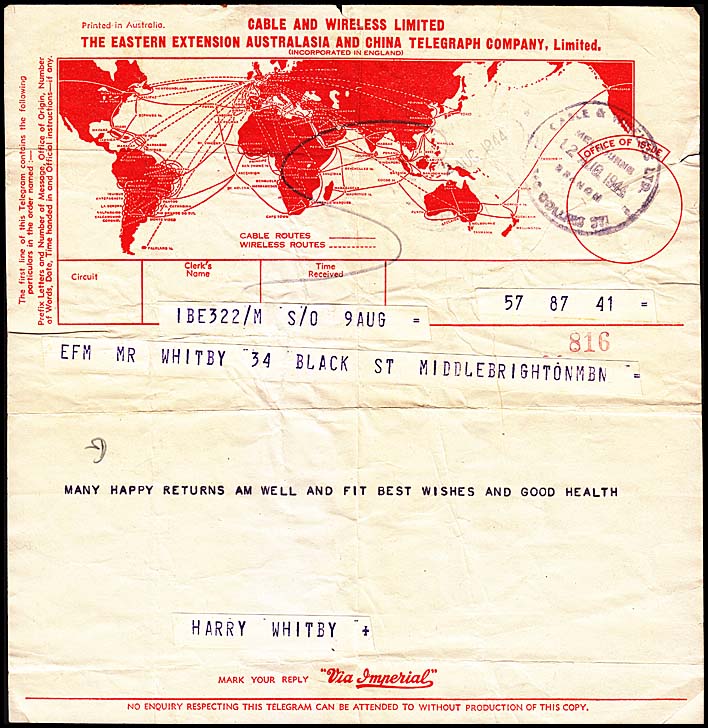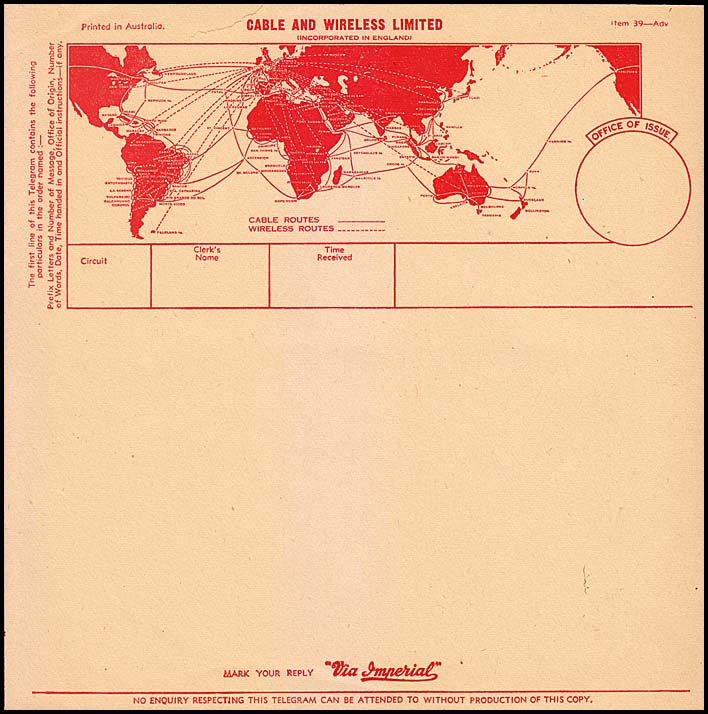Australia - International - Cable & Wireless.
Delivery form: IAC-DO-3.
Delivery form: IAC-DO-3.
- Home, index, site details
- Australia 1901-1988
-
New South Wales
- Overview of NSW
- Organisation
- Telegraph lines
- Telegraph Offices
- Date stamps
- Forms
- Envelopes
- Rates
- Stamps
-
Queensland
- Overview of Qld
- Telegraph lines
- Telegraph Offices
- Date stamps
- Forms
- Envelopes
- Rates
- Stamps
- Ephemera
-
South Australia
- Overview of SA
- Organisation
- Telegraph lines
- Telegraph offices
- Date stamps
- Forms
- Envelopes
- Rates
- Stamps
-
Tasmania
- Overview of Tasmania
- Organisation
- Telegraph lines
- Telegraph Offices
- Date stamps
- Forms
- Envelopes
- Railway lines
- Rates
- Stamps
-
Victoria
- Overview of Victoria
- Organisation
- Telegraph lines
- Telegraph Offices
- Date stamps
- Forms
- Envelopes
- Rates
- Stamps
- Ephemera
-
Western Australia
- Overview of WA
- Organisation
- Telegraph lines
- Telegraph offices
- Date stamps
- Forms
- Envelopes
- Rates
- Stamps
- International
- Special aspects
General characteristics:
| Heading and notes: | Cable & Wireless - also Eastern Extensionon the earlier printings in Australia. |
| Message area: | Blank. |
| Reverse side: | Blank. |
| Colours (text & form): | Red on cream. |
| Size of form overall: | 202 × 195 mm (later to 200 mm wide). |
| Size of datestamp box: | 33 mm diameter. |
Distinctive characteristics of this form:
- first form with Cable & Wireless at top;
- printed in Australia;
- probably all bound into pads with rubberised compound at the top. Only DO-3B is recorded as definitely being like this.
Cable & Wireless devolved responsibility for some aspects - including printing to some of the former Colonies.
Instructions from England of course had to followed. Hence the first printings in Australia of the delivery forms for international telegrams reversed the order of the organisations to make Cable & Wireless the lead organisation. Contractual obligations, related especially to the cable operation, made it a requirement to continue to use the reference to The Eastern Extension ... for some time until it was dropped.
Other members of the British Empire, without such a link, used a Cable & Wireless heading only
although many still had their forms printed in Mother England.
Instructions from England of course had to followed. Hence the first printings in Australia of the delivery forms for international telegrams reversed the order of the organisations to make Cable & Wireless the lead organisation. Contractual obligations, related especially to the cable operation, made it a requirement to continue to use the reference to The Eastern Extension ... for some time until it was dropped.
Other members of the British Empire, without such a link, used a Cable & Wireless heading only
although many still had their forms printed in Mother England.
Details of use and rarity.
| Form sub-number |
Schedule number | Earliest recorded date | Rarity rating |
| DO-3 | None | 1 September 1942 at C&W then Walkerville, SA. | R |



